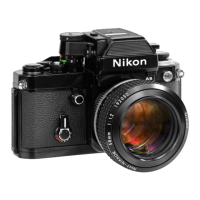24
EXPOSURE MEASUREMENT - continued
Exposure Control
The amount of light reaching the film plane is determined by
a combination of the lens aperture and the shutter speed. Since
the two are interrelated, different combinations will give the
same exposure. A 1-step change in the shutter speed, or a 1-
stop change in the aperture setting, will either halve or double
the exposure. For example, a shutter speed of 1/125 second
passes twice as much light as a setting of 1/250 second, and
only half as much light as a speed of 1/60 second; for an
aperture setting of f/11, twice as much light as f/16, and half
as much as f/8, is passed. This feature characterizes the op-
eration throughout the available range of shutter speeds and
aperture settings. With this in mind, it’s easy to see that if a
correct exposure for a scene is 1/125 at f/11, then 1/60 at f/16
or 1/250 at f/8 will be equally acceptable.
The best combination for your needs will depend on the re-
sults desired. Use fast shutter speeds to freeze motion, or use
slow speeds to produce deliberate and creative blur. Small
apertures give greater depth of field, while large apertures
restrict sharp focus to the main subject. The creative selec-
tion of both speeds and apertures will greatly enhance your
photography.
Metering Range
If the center “correct exposure” LED fails to illuminate, even
after all possible lens-aperture/shutter-speed combinations
have been tried, then the available light is too bright or too
dim for the meter’s range. To correct this situation, several
measures may be taken, as follows: Switch to a new film (ei-
ther higher or lower ASA) that more closely matches the avail-
able light; mount a neutral density filter on the lens to de-
crease the light reaching the film plane; or use artificial light-
ing (i.e., an electronic flash unit) to increase subject illumina-
tion. Remember, too, that the lens in use can greatly influence
suitability for bright or dim shooting. For example, a 50mm f/
1.4 lens (with ASA 100 film) couples from EV—2 (f/1.4 at 8
seconds) to EV 17 (f/8 at 1/2000 second) for excellent low-
light performance; on the other hand, a 200mm f/4 lens proves
more usable at bright-light levels, coupling (with ASA 100
film) from EV 1 (f/4 at 8 seconds) to EV 20 (f/22 at 1/2000).
Thus, choose the lens carefully to match the existing lighting
conditions.
WWW.LENSINC.NET

